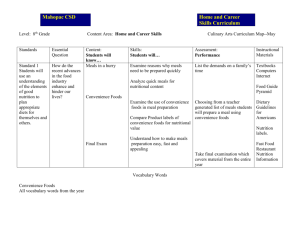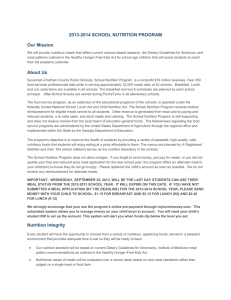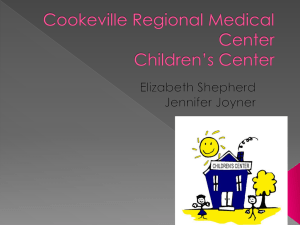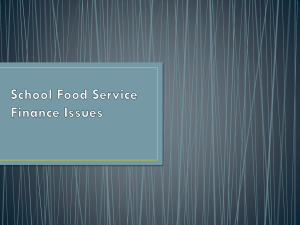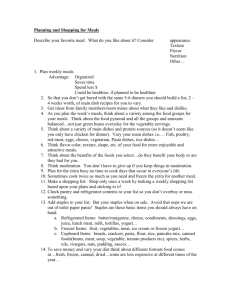Child Nutrition Programs - Alaska Department of Education
advertisement
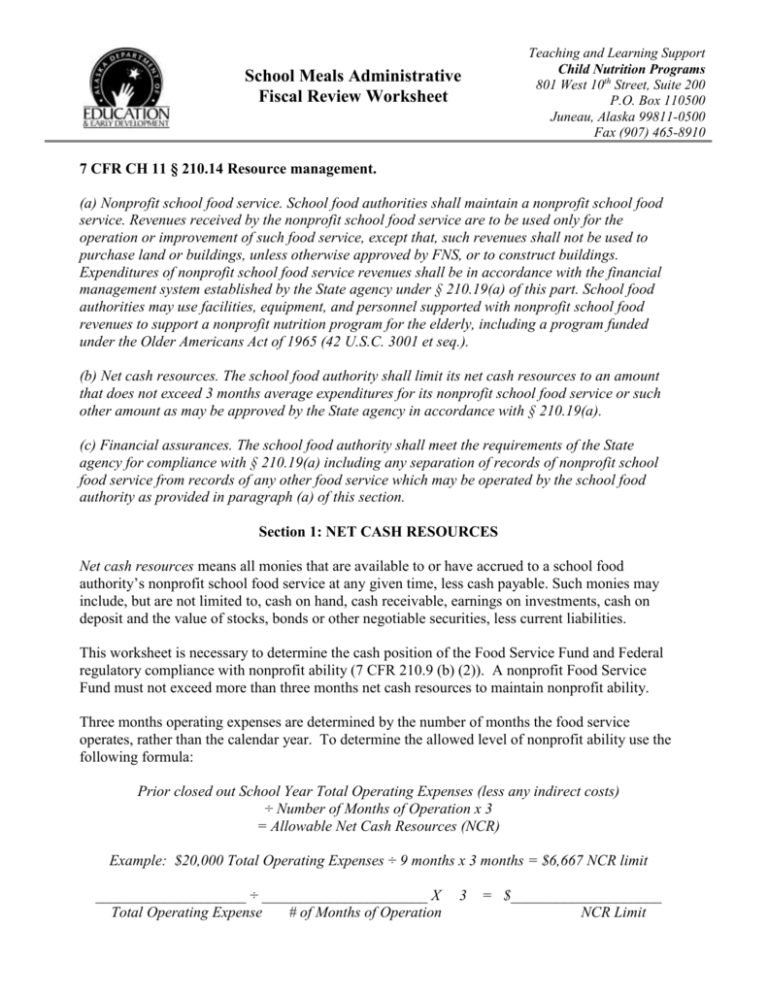
Teaching and Learning Support Child Nutrition Programs 801 West 10th Street, Suite 200 P.O. Box 110500 Juneau, Alaska 99811-0500 Fax (907) 465-8910 School Meals Administrative Fiscal Review Worksheet 7 CFR CH 11 § 210.14 Resource management. (a) Nonprofit school food service. School food authorities shall maintain a nonprofit school food service. Revenues received by the nonprofit school food service are to be used only for the operation or improvement of such food service, except that, such revenues shall not be used to purchase land or buildings, unless otherwise approved by FNS, or to construct buildings. Expenditures of nonprofit school food service revenues shall be in accordance with the financial management system established by the State agency under § 210.19(a) of this part. School food authorities may use facilities, equipment, and personnel supported with nonprofit school food revenues to support a nonprofit nutrition program for the elderly, including a program funded under the Older Americans Act of 1965 (42 U.S.C. 3001 et seq.). (b) Net cash resources. The school food authority shall limit its net cash resources to an amount that does not exceed 3 months average expenditures for its nonprofit school food service or such other amount as may be approved by the State agency in accordance with § 210.19(a). (c) Financial assurances. The school food authority shall meet the requirements of the State agency for compliance with § 210.19(a) including any separation of records of nonprofit school food service from records of any other food service which may be operated by the school food authority as provided in paragraph (a) of this section. Section 1: NET CASH RESOURCES Net cash resources means all monies that are available to or have accrued to a school food authority’s nonprofit school food service at any given time, less cash payable. Such monies may include, but are not limited to, cash on hand, cash receivable, earnings on investments, cash on deposit and the value of stocks, bonds or other negotiable securities, less current liabilities. This worksheet is necessary to determine the cash position of the Food Service Fund and Federal regulatory compliance with nonprofit ability (7 CFR 210.9 (b) (2)). A nonprofit Food Service Fund must not exceed more than three months net cash resources to maintain nonprofit ability. Three months operating expenses are determined by the number of months the food service operates, rather than the calendar year. To determine the allowed level of nonprofit ability use the following formula: Prior closed out School Year Total Operating Expenses (less any indirect costs) ÷ Number of Months of Operation x 3 = Allowable Net Cash Resources (NCR) Example: $20,000 Total Operating Expenses ÷ 9 months x 3 months = $6,667 NCR limit ____________________ ÷ ______________________ X Total Operating Expense # of Months of Operation 3 = $____________________ NCR Limit School Meals Administrative Fiscal Review Worksheet Page 2 of 6 Please note that the above equation only needs to be calculated one time for the entire program year. The NCR limit from above will be compared to the NCR total calculated below. If the net cash resources in any month exceed the NCR Limit (above), please send a copy of the completed form to Child Nutrition Programs for further review. NET CASH RESOURCES SPONSOR: _________________________________ as of ______________, 20____________ Month/Date To fill in the table below use the annual totals of the most recently closed-out year. This information should be available on the Statement of Revenues and Expenses, the General Ledger or other similar documents. Revenue Meal Sales State Match Federal Reimbursement Interest Other Step 1: Total Revenue $ $ $ $ $ Expenses Labor Food Supplies Transportation Indirect Cost Due to Other Funds Step 2: Expenses $ $ $ $ $ $ $ $ Net Cash Resources Subtract Total Expenses (Step 2) from Total Revenue (Step 1) Step 3: Net Cash Resources $ **Definitions are found in the Definitions Section at the end of this document. Alaska Department of Education & Early Development Child Nutrition Programs Rev. 2/15 School Meals Administrative Fiscal Review Worksheet Page 3 of 6 Section 2: REVENUE FOR NON-PROGRAM FOODS SOLD IN SCHOOLS Non-Program Food Revenue means: Revenue from foods sold outside of reimbursable meals when those foods are purchased with school food service account funds (7 CFR 210.14 (f)). What is considered a non-program food? FNS defines non-program foods as those foods and beverages sold in a participating school other than reimbursable meals and meal supplements that are purchased using funds from the nonprofit school food service account. These include but are not limited to: A la carte items sold in competition with school meals; Adult meals; Items purchased for fund raisers, vending machines, school stores, etc.; and Items purchased for catered and vended meals. What is considered revenue? Revenue is all money that is provided to the nonprofit school food service account. This includes but is not limited to: Federal reimbursement; State or local funds, such as per meal subsidies and State revenue matching funds; Children’s payments for reimbursable meals and a la carte sales; Payments for items purchased for fund raisers, vending machines, etc.; and Income from catering, adult meals, vended meals, etc. How does a SFA determine the “cost to obtain” a non-program food? The cost to obtain a non-program food includes only the cost of the food. If a non-program food is made from scratch, the SFA would determine the price of ingredients to calculate the food cost. The SFA should not include labor or other costs in this calculation. This same principle applies to calculating program food costs for the purpose of this provision. How does a SFA determine whether it is in compliance with the Revenue from Non-program Foods Sold in Schools provision? The SFA would determine its total food cost and the proportion of that total that is non-program food. The SFA would then calculate the share of total revenue generated from non-program food sales over the same period. If the second figure is at least as great as the first figure, then the SFA is generating sufficient revenue from non-program food sales. ____ N/A Check if your school/site does not have Revenue for Non-Program Foods. If your school/site does not have Revenue for Non-Program Foods, you do not need to fill out Section 2. Alaska Department of Education & Early Development Child Nutrition Programs Rev. 2/15 School Meals Administrative Fiscal Review Worksheet Page 4 of 6 The following example shows how this provision is applied: An SFA has the following characteristics: Total Costs: $1,000,000 Total Food Costs: $500,000 o Cost of food for reimbursable meals: $450,000 o Cost of non-program food: $50,000 Total Revenue: $1,000,000 Revenue Requirement: Minimum proportion of revenue required from the sale of non-program foods: o $50,000/$500,000 = 10% Minimum dollar revenue required from the sale of non-program foods: o 10% x $1,000,000 = $100,000 If this SFA earns $100,000 in revenue from non-program food sales, they are in compliance. Non-Program Revenue: Enter the cost for Reimbursable meal, cost of non-program food and total revenue. A. **Cost for Reimbursable Meal Food $ B. **Cost of Non-program Food $ C. **Total Food Costs $ D. E **Total Non-program Food Revenue **Total Revenue $ $ Minimum portion of revenue from non-program funds (B Cost of Non-program Foods/C Total Food Costs = F) F. Minimum Revenue Required from the Sale of Non-program Foods G. (F times E Total Revenue = G) Additional Revenue Needed to Comply (G minus D, if less than zero, enter zero) H. **Definitions are found in the Definitions Section at the end of this document. Alaska Department of Education & Early Development Child Nutrition Programs Rev. 2/15 School Meals Administrative Fiscal Review Worksheet Page 5 of 6 For the electronic Non-program Revenue Tool see the attachment under Additional Topics: SP392011 Non-Program Foods Rev. Calculator, at: http://education.alaska.gov/tls/cnp/NSLP9.html . If you complete the electronic version please submit it to the Child Nutrition Programs for review. For more information on Revenue for Non-Program Foods Sold in Schools see USDA Policy memo SP39-2011, at: http://www.fns.usda.gov/cnd/governance/Policy-Memos/2011/SP392011osr.pdf. Section 3: INDIRECT COSTS Please answer the two question regarding indirect costs for your district/site. Did the SFA charge the school food service account for indirect costs? Yes/No If yes, please explain: _____________________________________________________________ Did the LEA charge indirect costs at the State agency's approved rate? Yes/No If No, please explain: _____________________________________________________________ If you have questions regarding this worksheet, please call the Child Nutrition Programs office at (907) 465-8709. DEFINITIONS Section 1: Net Cash Resources Meal Sales: Revenue earned from the sale of meals. State Match: Reimbursement from the State. Federal Reimbursements: Payments received from federal funds for reimbursable meals, afterschool care snacks and suppers, as well as the value of USDA Foods received, cash received in lieu of USDA Foods, federal grants and funds for other federal nutrition programs. Interest: Interest earned on revenue. Other: Funds bring transferred from the Genial Fund, or other non-federal accounts. Labor: Salaries, wages and benefits owed, but not paid until after the statement of net position date. For example, in some school districts, salaries are earned in nine or ten months but spread over twelve months; thus some salaries paid on July 31 may actually been earned (accrued) by the end of May. Food: The amount expended for the purchase of all foods sold in the school nutrition operation, charges for processing USDA Foods from bulk or raw form to ready-to-use end products, and the cost of the USDA Foods delivery to school districts. Alaska Department of Education & Early Development Child Nutrition Programs Rev. 2/15 School Meals Administrative Fiscal Review Worksheet Page 6 of 6 Supplies: Cost of general supplies necessary for the operation of the school nutrition program, including office supplies, paper or disposable supplies used only for the production and service of food at the school site. Transportation: Shipping expenses paid by school. Indirect: General school district overhead attributable to the school nutrition operation, including school nutrition activities and support services provided by other district departments that are recovered through an approved allocation plan. Section 2: Revenue for Non-Program foods sold in Schools Cost of Reimbursable Meal Food: Refers to the amount paid for food purchased to be a part of a reimbursable meal. Cost of Non-program Food: Refers to the amount paid for food sold in a participating school other than a reimbursable meal and is purchased using funds from the school food service account of the school. This is a broad definition and includes beverages, a la carte foods, and any extra reimbursable foods that are sold such as an extra slice of pizza or carton of milk. Total Food Cost: Refers to the total amount paid for food for both reimbursable meals and nonprogram food purchased with the school food service account. Total Non-program Food Revenue: Refers to all funds accumulated to the school food service account associated with the sale of non-program foods. Total Revenue: Refers to all funds accumulated to the school food service account. Alaska Department of Education & Early Development Child Nutrition Programs Rev. 2/15
